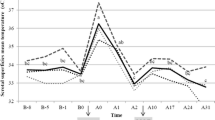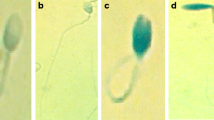Abstract
We have previously demonstrated that scrotal hyperthermia induce Leydig cell (LC) damage in short-term. The objectives of this pilot study were to investigate morphological changes and regulation of steroidogenesis on LC in long-term and the time of observation were extended to investigate whether the LC would eventually make a recovery after scrotal hyperthermia. The rats were randomly allotted into one of four groups: A (control), B (70 days after scrotal hyperthermia), C (105 days after scrotal hyperthermia), D (140 days after scrotal hyperthermia); each group contain seven animals. Scrotal hyperthermia was carried out in a thermostatically controlled water bath at 43°C for 30 min once daily for six consecutive days. Control rats were treated in the same way, except the testes were immersed in a water bath maintained at 22°C. Hyperthermia applied rats were sacrificed under 50 mg/kg ketamine anaesthesia after 70, 105 and 140 days, and biopsy materials of testes were obtained for light and electron microscopic examinations. Morphologically normal and the number of testosterone positive LC was significantly higher in 140 days after last heat than all other heat treatment groups. In heat treated groups, a dilated smooth endoplasmic reticulum, swollen mitochondria, and vanished mitochondrial cristae were observed. In the 140 days after scrotal hyperthermia, the severities of degenerative changes of LC were less than that observed in the other heat treated groups. We conclude that, scrotal hyperthermia cause morphological damaging and impaired steroidogenesis in LC and recovery of these findings were noted first time in 140 days after the last heat treatment.



Similar content being viewed by others
References
Aktas C, Kanter M (2009) A morphological study on Leydig cells of scrotal hyperthermia applied rats in short-term. J Mol Histol 40(1):31–39. doi:10.1007/s10735-009-9210-9
Bedrak E, Samiloff V, Sod-Moriah UA (1973) Metabolism of 3b-hydroxy-5-ene steroids by testes of rats acclimatized to a hot environment. J Endocrinol 58:207–217. doi:10.1677/joe.0.0580207
Bowler K (1972) The effect of repeated applications of heat on spermatogenesis in the rat: a histological study. J Reprod Fertil 28:325–333. doi:10.1530/jrf.0.0280325
Christensen AK (1975) Leydig cells. In: Hamilton DW, Greep RO (eds) Handbook of physiology, Sec 7, vol 5. American Physiological Society, Washington, USA, pp 57–94
Damber JE, Bergh A, Janson PO (1978) Testicular blood flow and testosterone concentrations in the spermatic venous blood in rats with experimental cryptorchidism. Acta Endocrinol (Copenh) 88:611–618
Damber JE, Bergh A, Janson PO (1980) Leydig cell function and morphology in the rat testis after exposure to heat. Andrologia 12:12–19
Ewing LL, Brown BL (1977) Testicular steroidogenesis. In: Johnson AD, Gomes WR (eds) The testis, vol 4. Academic Press, New York, p 239
Griswold WD (1988) Protein secretion of Sertoli cells. Int Rev Cytol 110:133–156. doi:10.1016/S0074-7696(08)61849-5
Haider SG (2004) Cell biology of Leydig cells in the testis. Int Rev Cytol 233:181–241. doi:10.1016/S0074-7696(04)33005-6
Hales DB (2002) Testicular macrophage modulation of Leydig cell steroidogenesis. J Reprod Immunol 57:3–18. doi:10.1016/S0165-0378(02)00020-7
Harrison R, Weiner J (1948) Abdomino-testicular temperature gradients. J Physiol 18:256–262
Henriksen K, Hakovirta H, Parvinen M (1995) Testosterone inhibits and induces apoptosis in rat seminiferous tubules in a stage-specific manner: in situ quantification in squash preparations after administration of ethane dimethane sulfonate. Endocrinology 136:3285–3291. doi:10.1210/en.136.8.3285
Hjollund NH, Bonde JP, Jensen TK, Olsen J (2000) Diurnal scrotal skin temperature and semen quality. The Danish first pregnancy planner study team. Int J Androl 23:309–318. doi:10.1046/j.1365-2605.2000.00245.x
Hjollund NH, Storgaard L, Ernst E, Bonde JP, Olsen J (2002) Impact of diurnal scrotal temperature on semen quality. Reprod Toxicol 16:215–221. doi:10.1016/S0890-6238(02)00025-4
Hsu SM, Raine L, Fanger H (1981) Use of avidin–biotin-peroxidase complex (ABC) in immunperoxidase techniques: a comparison between ABC and unlabeled antibody (PAP) procedures. J Histochem Cytochem 29:577–580
Jannes P, Spiessens C, Van der Auwera I, D’Hooghe T, Verhoeven G, Vanderschueren D (1998) Male subfertility induced by acute scrotal heating affects embryo quality in normal female mice. Hum Reprod 13:372–375. doi:10.1093/humrep/13.2.372
Liu Z, Stocco DM (1997) Heat shock-induced inhibition of acute steroidogenesis in MA-10 cells is associated with inhibition of the synthesis of the steroidogenic acute regulatory protein. Endocrinology 138:2722–2728. doi:10.1210/en.138.7.2722
Lue Y-H, Sinha Hikim AP, Swerdloff RS, Im P, Seng Taing K, Bui T et al (1999) Single exposure to heat induces stage-specific germ cell apoptosis in rats: role of intratesticular testosterone on stage specificity. Endocrinology 140:1709–1717. doi:10.1210/en.140.4.1709
Lue Y, Hikim AP, Wang C, Im M, Leung A, Swerdloff RS (2000) Testicular heat exposure enhances the suppression of spermatogenesis by testosterone in rats: the ‘two-hit’ approach to male contraceptive development. Endocrinology 141:1414–1424. doi:10.1210/en.141.4.1414
Lynch R, Lewis-Jones DI, Machin DG, Desmond AD (1986) Improved seminal characteristics in infertile men after a conservative treatment regimen based on the avoidance of testicular hyperthermia. Fertil Steril 46:476–479
Maines MD, Ewing JF (1996) Stress response of the rat testis: in situ hybridization and immunohistochemical analysis of heme oxygenase-1 (HSP32) induction by hyperthermia. Biol Reprod 54:1070–1079. doi:10.1095/biolreprod54.5.1070
Mieusset R, Bujan L, Mondinat C, Mansat A, Pontonnier F, Grandjean H (1987) Association of scrotal hyperthermia with impaired spermatogenesis in infertile men. Fertil Steril 48:1006–1011
Munabi AK, Cassorla FG, D’Agata R (1984) The effects of temperature on the activity of testicular steroidogenic enzymes. Steroids 43:325–331. doi:10.1016/0039-128X(84)90050-3
Murphy BD, Lalli E, Walsh LP, Liu Z, Soh J, Stocco DM, Sassone-Corsi P (2001) Heat shock interferes with steroidogenesis by reducing transcription of the steroidogenic acute regulatory protein gene. Mol Endocrinol 15:1255–1263. doi:10.1210/me.15.8.1255
Papadopoulos V (2007) Environmental factors that disrupt Leydig cell steroidogenesis. In: Payne AH, Hardy MP (eds) The Leydig cell in health and disease. Humana Press Inc., Totowa, pp 393–413
Ren L, Medan MS, Ozu M, Li C, Watanabe G, Taya K (2006) Effects of experimental cryptorchidism on sperm motility and testicular endocrinology in adult male rats. J Reprod Dev 52:219–228. doi:10.1262/jrd.17073
Rockett JC, Mapp FL, Garges JB, Luft JC, Mori C, Dix DJ (2001) Effects of hyperthermia on spermatogenesis, apoptosis, gene expression, and fertility in adult male mice. Biol Reprod 65:229–239. doi:10.1095/biolreprod65.1.229
Saez JM (1994) Leydig cells. Endocr Paracrine Autocrine Regul Endocr Rev 15:574–626
Setchell BP (1998) The Parkes lecture: heat and the testis. J Reprod Fertil 114:179–194. doi:10.1530/jrf.0.1140179
Setchell BP, Bergh A, Widmark A, Damber JE (1995) Effect of testicular temperature on vasomotion and blood flow. Int J Androl 18:120–126. doi:10.1111/j.1365-2605.1995.tb00397.x
Setchell BP, Plöen L, Ritzen EM (2001) Reduction of long-term effects of local heating of the testis by treatment of rats with GnRH agonist and an anti-androgen. Reproduction 122:255–263. doi:10.1530/rep.0.1220255
Shikone T, Billig H, Hsueh AJW (1994) Experimentally induced cryptorchidism increases apoptosis in the rat testis. Biol Reprod 51:865–872. doi:10.1095/biolreprod51.5.865
Tapanainen JS, Tilly JL, Vihko KK, Hsueh AJ (1993) Hormonal control of apoptotic cell death in the testis: gonadotropins and androgens as testicular cell survival factors. Mol Endocrinol 7:643–650. doi:10.1210/me.7.5.643
Teerds KJ (1996) Regeneration of Leydig cells after depletion by EDS. In: Payne AH, Hardy MP, Russell LD (eds) The Leydig cell. Cache River Press, Vienna-Illinois, pp 204–219
Teerds KJ, De Rooij DG, Rommerts FFG, Van Den Hurk R, Wensing CJG (1989) Stimulation of the proliferation and differentiation of Leydig cell precursors after the destruction of existing Leydig cells with ethane dimethyl sulphonate (EDS) can take place in the absence of LH. J Androl 10:472–477
Troiano L, Fustini MF, Lovato E, Frasoldati A, Malorni W, Capri M, Grassilli E, Marrama P, Franceschi C (1994) Apoptosis and spermatogenesis: evidence from an in vivo model of testosterone withdrawal in the adult rat. Biochem Biophys Res Commun 202:1315–1321. doi:10.1006/bbrc.1994.2074
Ulberg L (1958) The influence of high temperature on reproduction. J Hered 49:62–64
Yaeram J, Setchell BP, Maddocks S (2006) Effects of heat stress on the fertility of male mice in vivo and in vitro. Reprod Fertil Dev 18:647–653. doi:10.1071/RD05022
Author information
Authors and Affiliations
Corresponding author
Rights and permissions
About this article
Cite this article
Kanter, M., Aktas, C. Effects of scrotal hyperthermia on Leydig cells in long-term: a histological, immunohistochemical and ultrastructural study in rats. J Mol Hist 40, 123–130 (2009). https://doi.org/10.1007/s10735-009-9222-5
Received:
Accepted:
Published:
Issue Date:
DOI: https://doi.org/10.1007/s10735-009-9222-5




